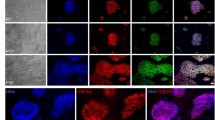Abstract
Human embryonic stem cells (hESCs) can differentiate into any cell lineage (pluripotency potential) derived from the three germ layers: ectoderm, mesoderm, and endoderm. Pluripotency is usually demonstrated in vitro by spontaneous differentiation of hESCs grown on a monolayer of feeder-cells using an embryoid bodies (EBs)-based method. However, currently hESCs are grown mostly using fully defined media in the absence of a feeder layer. Here we describe a EBs-based protocol that allows multilineage differentiation of hESCs and human induced pluripotent stem cells (hiPSCs) grown on feeder-free conditions.
Access this chapter
Tax calculation will be finalised at checkout
Purchases are for personal use only
Similar content being viewed by others
References
Thomson JA, Itskovitz-Eldor J, Shapiro SS, Waknitz MA, Swiergiel JJ, Marshall VS, Jones JM (1998) Embryonic stem cell lines derived from human blastocysts. Science 282(5391):1145–1147. https://doi.org/10.1126/science.282.5391.1145
Takahashi K, Tanabe K, Ohnuki M, Narita M, Ichisaka T, Tomoda K, Yamanaka S (2007) Induction of pluripotent stem cells from adult human fibroblasts by defined factors. Cell 131(5):861–872. https://doi.org/10.1016/j.cell.2007.11.019
Nichols J, Smith A (2012) Pluripotency in the embryo and in culture. Cold Spring Harb Perspect Biol 4(8):a008128. https://doi.org/10.1101/cshperspect.a008128
Yilmaz A, Benvenisty N (2019) Defining human pluripotency. Cell Stem Cell 25(1):9–22. https://doi.org/10.1016/j.stem.2019.06.010
Wobus AM, Loser P (2011) Present state and future perspectives of using pluripotent stem cells in toxicology research. Arch Toxicol 85(2):79–117. https://doi.org/10.1007/s00204-010-0641-6
Liu G, David BT, Trawczynski M, Fessler RG (2020) Advances in pluripotent stem cells: history, mechanisms, technologies, and applications. Stem Cell Rev Rep 16(1):3–32. https://doi.org/10.1007/s12015-019-09935-x
Dakhore S, Nayer B, Hasegawa K (2018) Human pluripotent stem cell culture: current status, challenges, and advancement. Stem Cells Int 2018:7396905. https://doi.org/10.1155/2018/7396905
Sun N, Panetta NJ, Gupta DM, Wilson KD, Lee A, Jia F, Hu S, Cherry AM, Robbins RC, Longaker MT, Wu JC (2009) Feeder-free derivation of induced pluripotent stem cells from adult human adipose stem cells. Proc Natl Acad Sci U S A 106(37):15720–15725. https://doi.org/10.1073/pnas.0908450106
Smith KP, Luong MX, Stein GS (2009) Pluripotency: toward a gold standard for human ES and iPS cells. J Cell Physiol 220(1):21–29. https://doi.org/10.1002/jcp.21681
Odorico JS, Kaufman DS, Thomson JA (2001) Multilineage differentiation from human embryonic stem cell lines. Stem Cells 19(3):193–204. https://doi.org/10.1634/stemcells.19-3-193
Isaja L, Rodriguez-Varela MS, Marazita M, Mucci S, Itzcovich T, Chrem-Mendez P, Niikado M, Ferriol-Laffouillere SL, Allegri R, Martinetto H, Sevlever GE, Scassa ME, Surace EI, Romorini L (2021) Generation of a human induced pluripotent stem cell line from a familial Alzheimer’s disease PSEN1 T119I patient. Stem Cell Res 53:102325. https://doi.org/10.1016/j.scr.2021.102325
Author information
Authors and Affiliations
Corresponding author
Editor information
Editors and Affiliations
Rights and permissions
Copyright information
© 2021 Springer Science+Business Media, LLC
About this protocol
Cite this protocol
Isaja, L., Ferriol-Laffouillere, S.L., Mucci, S., Rodríguez-Varela, M.S., Romorini, L. (2021). Embryoid Bodies–Based Multilineage Differentiation of Human Embryonic Stem Cells Grown on Feeder-Free Conditions. In: Turksen, K. (eds) Embryonic Stem Cell Protocols . Methods in Molecular Biology, vol 2520. Humana, New York, NY. https://doi.org/10.1007/7651_2021_440
Download citation
DOI: https://doi.org/10.1007/7651_2021_440
Published:
Publisher Name: Humana, New York, NY
Print ISBN: 978-1-0716-2436-4
Online ISBN: 978-1-0716-2437-1
eBook Packages: Springer Protocols




